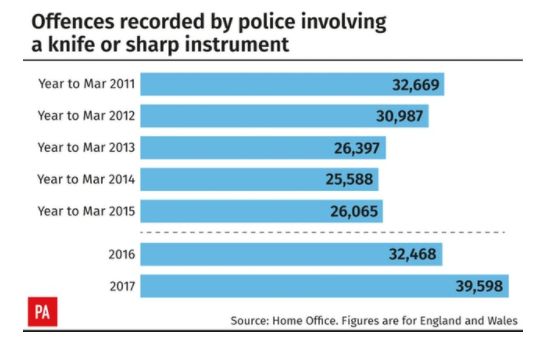
Police forces across the country have recorded sharp increases in knife and gun crime, figures likely to fuel mounting concern over rising levels of violence.
The findings are likely to place the government’s efforts to make Britain’s streets safer under even more scrutiny, as statisticians report a clear increase in “high-harm” violent offences.
Police forces logged 39,598 offences involving a knife or sharp instrument in 2017, a 22% increase compared with the previous year, and the highest number registered since comparable records started in 2010.
Official figures show police forces in England and Wales also recorded rises in homicide and robbery last year.
Offences involving firearms were also up, by 11% to 6,604 recorded crimes.
Responding to the figures, the Mayor of London, Sadiq Khan, said: “These statistics show once again that crime, and violent crime in particular, is rising at an unacceptably high rate across the whole of England and Wales, including London.
“This is clearly a national problem that requires national solutions from the Government.”

John Poyton, CEO at youth charity Redthread said: “These crime statistics throw into sharp relief the urgent need to adopt a public health approach to tackling violence. This model combines resources from the police, health, education and the community to create a long-term attitudinal change in society, rather than treating violence just as a criminal justice issue.
“We need to treat violence as a disease. Analyse the causes, diagnose the problem, look at what works to treat the symptoms and develop solutions.”
The offences were disproportionately concentrated in London and other metropolitan areas, the Office for National Statistics said, but it added that the majority of police forces saw rises in these types of violent crime.
The figures showed the number of homicides went up by 54, or 9%, to a total of 653, when cases linked to the Hillsborough disaster and last year’s terror attacks were excluded.
In the overall category of “violence against the person”, there were 1.3 million crimes logged, a rise of a fifth on 2016.
Recorded burglary and robbery offences went up by 9% and 33% respectively, while the separate Crime Survey for England and Wales showed a 17% jump in vehicle thefts.
In total, police recorded 5.4 million offences, a 13% year-on-year rise.
ONS statistician Alexa Bradley said: “Today’s figures show that, for most types of offence, the picture of crime has been fairly stable, with levels much lower than the peak seen in the mid-1990s.”
Earlier this month Home Secretary Amber Rudd launched a multi-pronged strategy to tackle serious violence.
But the blueprint – unveiled against a backdrop of rising concern following a flurry of killings in London – was overshadowed by a fresh row over police numbers.
Assistant Commissioner Martin Hewitt, responsible for Territorial Policing, said: “The Met continues to experience a very busy and challenging time against the backdrop of significant reductions in resources.”
He added that the force was “strengthening local policing by bringing specialist officers closer to communities”, and said it would be increasing the number of neighbourhood officers.
Sheldon Thomas, the founder of Gangsline, which runs outreach programmes with young men and women involved in gang culture, said ministers should be handing strategy over to those working directly with children and teens.
He said: “Don’t consult people like me at the end – come to us at the beginning. Pay us, give us the resources, and we will come up with a strategy and implement it.”
Denise Hatton, chief executive of YMCA England and Wales, linked the figures to government cuts to youth services.
She said: “Unfortunately it is not until news of young people’s loneliness or incidents like the recent knife crimes in London hit the headlines, the role of youth services is in the spotlight. But like all news cycles, this will pass and public outrage will simmer down, yet cuts to youth services will continue if local authorities don’t recognise its vital benefits to the development of young people.
“Without drastic action to protect funding and making youth services a statutory service, we are condemning young people to become a lonely, lost generation with nowhere to turn.”
